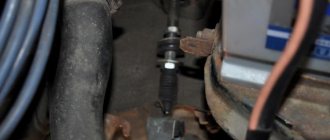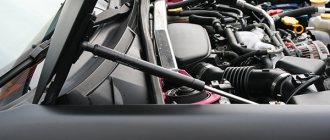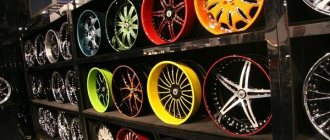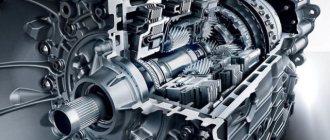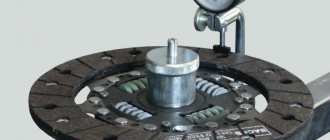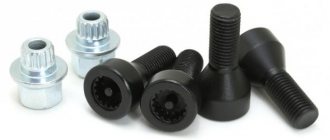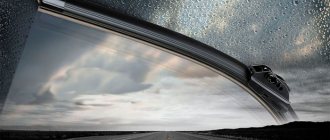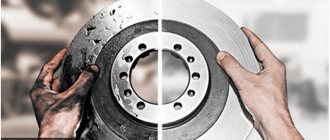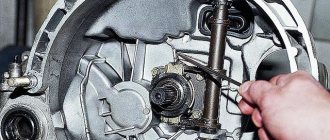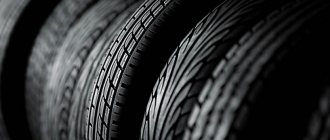The history of the dual clutch transmission
Dual clutch transmission
The idea of a double clutch first came to the Frenchman Adolphe Kegresse before the Second World War. However, this inventor never saw his innovation in working condition. After this, development of the dual clutch resumed in 1980 under the leadership of Harry Webster. The first prototypes were installed on the Ford Fiesta and Peugeot 205. Since then, devices of this type have only been improved. And today, many modified cars are equipped with 7-speed dual-clutch sports automatic transmissions.
A little history
The creator of the double clutch system for gearboxes is considered to be a designer named Adolf Kegress.
This French engineer, back in 1939 for most of us, outlined the basic essence of how a double clutch works. Some time later, this development began to be used on some racing cars. Although, in the end, the idea gathered dust on the shelves for a long time, and remained fully realized only on paper. 40 years later, engineers from the German company Porsche remembered the idea of Kegress. They began to actively study the device and fully implement the design ideas into reality.
So Porsche should be considered the first automaker to use the double-clutch principle on gearboxes in its cars. Their engineers clearly showed how it is possible to change gears when the gearbox is under load, without simultaneously reducing the speed of the power plant.
At that time, namely in 1980, the development became a revolution and real progress in the automotive industry. With the help of innovation, it was possible to significantly reduce the influence of the turbo lag effect, which for turbocharged engines of that time was a real problem that could not be eliminated.
As a result, the switching became smooth and uniform, and various jerks and dips disappeared. This made it possible to fully transmit torque without any serious and noticeable losses.
Operating principle of a dual clutch transmission
In order to understand how a double clutch works, it is necessary to consider its structure. This system is a combination of 2 manual transmissions that operate alternately. One of them is responsible for odd gears and reverse, while the 2nd is responsible for even ones. In this case, gear shifting occurs automatically. For example, you start driving in 1st gear, and as the speed increases, the system is already preparing 2nd gear. During their change, the first gear opens, while the second closes almost simultaneously. According to the developers, the dual-clutch transmission takes only 8 milliseconds to change gears. This efficiency allows a continuous flow of power from the engine to the wheels during gear changes in a device such as a dual clutch. The operating principle of this miracle mechanism is to analyze the following indicators:
- shaft rotation speed,
- rotation speed of all wheels,
- position of the lever on the gearbox,
- position of the gas and brake pedals.
The dual clutch automatic system evaluates these parameters and decides which gear to shift the box into.
Benefits of a dual clutch system
Automatic transmission with dual clutch
According to analysts, very soon the dual-clutch transmission will conquer more than 25% of the automobile market. The innovative transmission will achieve such incredible popularity thanks to its strengths:
- smooth running of the car and no jerking when driving,
- fast and dynamic acceleration,
- the ability to change gears automatically or manually;
- fuel consumption is reduced compared to a single gearbox by approximately 15%,
- sports performance improves,
- the connection between the engine and the gearbox is not broken when changing gears,
- torque is not lost,
- saving time on gear shifting.
Disadvantages of a dual clutch transmission
Double clutch device
Many of the disadvantages that hinder the widespread popularity of dual-clutch transmissions in our country will disappear over time. However, today owners may face some difficulties.
- Expensive content
- Cars with such a box are a little more expensive.
- In emergency situations, the dual clutch device may malfunction. After all, the system still needs to understand which gear to select.
- On the Russian market, cars with double clutches are still considered innovative, so it is quite difficult to find an experienced master who is well versed in this issue.
Over time, when the double clutch firmly steps onto our soil, there will be auto repair shops specializing in this, and the prices will not be as exorbitant as they are now.
How does a dry or wet dual clutch work?
Depending on the friction surface of the device, a distinction is made between wet and dry clutches. The wet version assumes the presence of a hydraulic pump and an oil reservoir in which the discs are located. It is believed that this design consumes more gasoline and takes up more space compared to its dry version, which differs only in that it does not use a large amount of oil. The disadvantages of this clutch are: limitation of transmitted torque and complex control programming. It is impossible to say exactly which clutch is better; everything will depend on the individual characteristics of the car and its engine.
Type of mechanisms
They are called dry and wet clutches. When choosing a car with such a robotic gearbox, you should pay attention to what kind of clutch is used in their transmissions, dry or wet. Different manufacturers use different versions of the system.
At the moment, the dry clutch type is considered the most common. According to statistics, it accounts for about 70% of all cars with similar gearboxes, characterized by the presence of a double clutch type. Wet systems are still less common. But their advantages include a longer service life.
It is also noteworthy that there are automakers who simultaneously use two types of gearboxes with different clutches for their cars. A striking example is the German automaker Volkswagen. Their range includes a robotic gearbox, labeled DSG 6. This is a wet version of the double clutch. But there is also a DSG 7 gearbox. And this is a dry type of execution.
Despite the apparent similarity, the difference between these two types of clutch is really significant.
- Dry type. This is an almost full-fledged analogue of a mechanical clutch, that is, the system is quite close to mechanics. It uses disks that rotate in the air. Purely physically, they are very similar to the discs that are used on manual transmissions. The process of compression and expansion is carried out thanks to the operation of an electric drive.
- Wet type. And this is a different double clutch. A distinctive feature is the fact that the discs rotate in a wet environment. Namely, in transmission oil. The expansion and compression process is carried out by a hydraulic system. Here we are talking about an impressive similarity with conventional automatic transmissions.
This may raise a logical question regarding the reasons for the increased reliability of the wet clutch, which is ahead of its dry counterparts in this parameter.
It's all about the transmission oil. This lubricant provides not only rotation, but also highly efficient cooling during operation. This feature allows the wet clutch to withstand increased loads at high speeds. Under high load they do not burn out, unlike a dry clutch.
Dry versions simply rotate in the air, which creates certain restrictions in terms of speed. They can't be too high. Otherwise, the disks will begin to overload, burn and fail. Replacement in such a situation is not such a cheap procedure.
The use of a double clutch was first mentioned in 1980 by Audi and Porsche, which used their designs for their own sports cars. Nowadays it has migrated to production models and is called:
- Speedshift from Mercedes-Benz;
- Twin Clutch SST for Mitsubishi;
- S-Tronic for Audi;
- 7DT – Porsche;
- Powershift - Ford;
- BMW – M DCT;
- DSG - Volkswagen.
This is not yet a complete list of manufacturers who use similar technology for their cars.
Despite the name of the automaker's company, it is completely different. Due to the complexity of the technology of operation of such a mechanism, manufacturers are distinguished:
- ZF for Porsche cars;
- Luk – for Volkswagen as a dry clutch;
- BorgWarner - for Volkswagen as a wet clutch;
- Ricardo is the most famous for the Bugatti Veyron;
- Getrag – for Chrysler, Volvo, Mercedes-Benz, Ferrari, Ford cars.
It often happens that automakers combine spare parts and individual systems from different manufacturers. For example, BMW uses a double clutch from BorgWarner and a gearbox from Getrag.
Automatic transmission suppliers for dual clutch vehicles
BMW M6 dual clutch
Each company that supplies dual-clutch transmissions advertises and praises its product in every possible way. They highlight their strengths, while carefully hiding their weaknesses. Although some manufacturers have earned a good reputation over many years of work. These famous companies include:
- BorgWarner : works closely with the Volkswagen Group;
- Fiat Powertrain Technologies : considered the manufacturer of the highest torque dry clutch;
- FEV GmbH : focuses on reducing the complexity of its devices, as well as their weight and size;
- Getrag : makes dual-clutch transmissions that emit much less CO2.
Other manufacturers that produce quality dual clutch transmissions include: Graziano, LuK, Ricardo and ZF .
Main functions, types and differences of a car clutch
So, the main task of the clutch is to smoothly connect the engine flywheel to the gearbox input shaft. This is necessary both when starting off and while driving to be able to change gears.
In simple words, the clutch allows you to “connect” and “disconnect” the gearbox and the engine, that is, it provides the ability to interrupt the supply of torque from the internal combustion engine to the transmission.
It is also worth noting that if you brake sharply while driving in a gear, the clutch protects the gearbox from overload, reducing the risk of premature gearbox failures.
- In terms of features, there are different types of clutch. As a rule, its types are divided into single-disc and multi-disc clutches (taking into account the number of driven discs). At the same time, single-disc clutches are more common than multi-disc clutches. The clutch can also be “dry” or “wet”.
Dry clutches are common and are actively used on cars with manual and manual transmissions. In the second case, it should be understood that the clutch operates in an oil bath. This clutch is often found on robotic preselective dual-clutch gearboxes.
The clutch is also divided according to the drive structure: mechanical, hydraulic, electric drive, as well as various combinations of these drives. You can also distinguish differences regarding the method of pressing the pressure disk. There are options with a circular arrangement of springs, as well as a clutch with a central diaphragm.
The car clutch diagram involves the following main elements:
- pressure disk;
- clutch disc (driven);
- release bearing;
- release bearing drive fork;
- clutch release drive (pedal);
If we consider the clutch of a car, the design of this unit is relatively simple. The clutch pressure plate, often called the clutch pressure plate, is a convex base that is circular in shape. This base has built-in special release springs connected to a round pressure pad.
The diameter of the indicated area is similar to the diameter of the flywheel; one side is ground. The pressure springs are directed to the center of the pressure plate (basket). At the moment of squeezing, they are affected by the release bearing. The basket itself is rigidly attached to the flywheel. The clutch driven disc is installed between the pressure pad and the flywheel.
The clutch driven disc is round in shape and has a radial base, friction linings and a splined clutch. The latter is necessary in order to connect the gearbox input shaft. The disc also has special damper springs (precipitators). The springs are located around the splined clutch and are needed to smooth out the vibrations that occur when the clutch is engaged.
Article on the topic: Glow ignition
There are also friction linings on the disc. The material used to make them can be carbon composite, Kevlar threads, ceramics and other options. The friction linings are attached to the base with rivets. The splined coupling located inside the linings is riveted in a similar way.
The next clutch element is the release bearing. One side of the bearing is a round pressure pad; the diameter of the pad corresponds to the release springs located in the center of the pressure plate.
The release bearing itself is placed on the gearbox input shaft, which protrudes from the box. In this case, the bearing is mounted not on the shaft, but on its protective casing. The release bearing is driven by the drive fork (rocker arm). In fact, the fork presses on the release bearing frame, where individual protrusions are made.
Also, in some cases, the fork and bearing can be additionally secured using locking springs. According to the principle of operation, the release bearing can also both press and retract the pressure springs.
- As for the clutch drive system, the simplest is mechanical (push clutch). In this case, the force on the pressure fork is transmitted by pressing the clutch pedal through a cable. The cable is located inside the casing, which is fixed in front of the clutch pedal and release fork.
The clutch hydraulic drive includes a main hydraulic cylinder and a slave cylinder, which are connected by a tube. When the driver presses the clutch pedal, force is transmitted to the master cylinder rod. At the end of the rod there is a piston that compresses the fluid (brake fluid is used as the working fluid) and creates pressure.
The working cylinder also has a rod, similarly connected to the piston. The piston also presses on the rod, which, in turn, acts on the release fork.
The electric clutch drive is based on an electric motor, which is activated when the clutch pedal is pressed. A cable is connected to the specified electric motor, and the system itself operates in the same way as a mechanical circuit.
Let’s also add that on a car with a manual transmission there is a separate clutch pedal (located on the left), while on a car with an automatic transmission, or rather, with a robot, there is no clutch pedal. Moreover, in the case of an automatic transmission of this type, it also has a clutch mechanism, but it operates without the participation of the driver.

